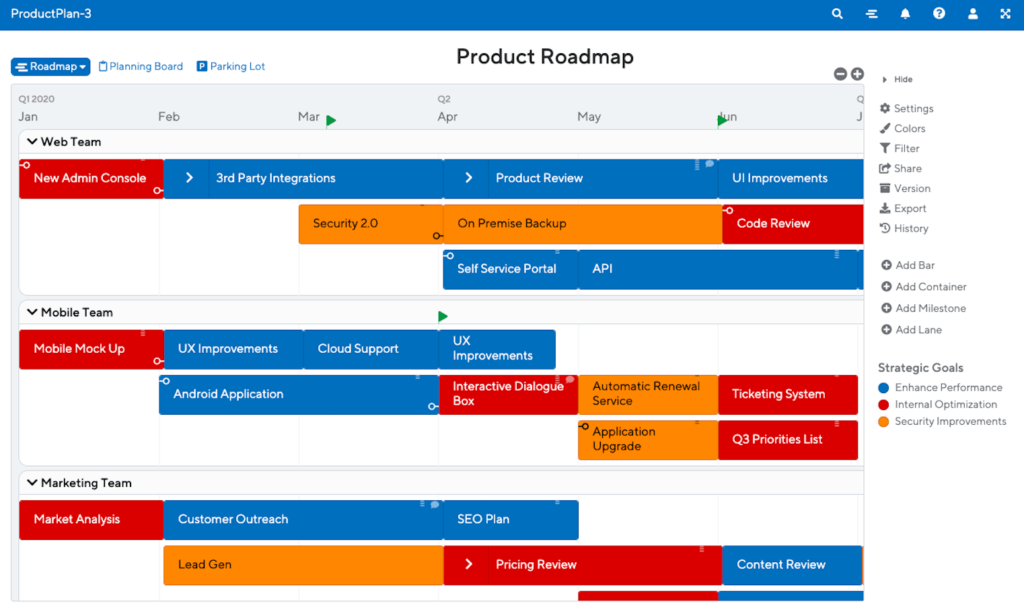As a product leader, face time with the company’s executive team is to be expected. Although product managers may not regularly attend management meetings, they will frequently have opportunities to demonstrate features, share customer learnings, and present roadmaps to the higher-ups in the company.
But product leaders are sometimes asked to present a product roadmap to a more exclusive audience that isn’t immersed in the daily operations of the company… and with much higher stakes. When given the opportunity to deliver an update or presentation to the company’s board, current financial backers or potential investors or acquirers, product leaders must adjust their content and delivery style to rise to the occasion.
How do you make sure you’re delivering the right message in an appropriate format to these heavy hitters, knowing everyone from the CEO on down is casting a critical eye on your every word? It’s all about tailoring your product roadmap presentation for the folks in the room.
Present your product roadmap with the audience in mind
Any product roadmap presentation (or any presentation for that matter) should be prepared specifically for the people it will be given to. A product roadmap presentation should be optimized for whoever will be attending it.
So who are these dealmakers you’ve been asked to present to and what is it they care about?
How to present your product roadmap to board members
The board is composed of individuals that have a fiduciary and legal responsibility to represent the best interests of the company’s shareholders. With that in mind, their sole goal is increasing the value of the company for an optimal eventual return on that investment.
“The board is the ultimate decision-making forum within any organization,” says board governance expert Julie Garland-McLellan. “Individual board members have very little power but the board as a whole, acting in consensus, is empowered to perform or delegate all of the business of the organization.”
This doesn’t mean that they’re looking to make a quick buck or turn the company into a billion-dollar unicorn, but it does mean they’re continually thinking about market value and potential exit opportunities, even if they’re years away. When they look at a product roadmap, they want to ensure this will make the company competitive and positioned for growth, as well as developing intellectual property and technology that would have value in the event of a potential acquisition.
Download The Product Roadmap Strategy Playbook ➜
Not all board members are necessarily investors, so their personal financial stakes may vary, but they do all have legal responsibilities tied to the company as well. Additionally, their reputations and egos are somewhat tied to the success of the company so they’re looking for headlines, publicity, and high valuations as well.
Their advice and recommendations are all aimed at positioning the company to be as successful as possible, and they may have influential contacts with potential strategic partners and customers they can offer up.
How to present your roadmap to current investors
Whether they’re wealthy individuals, venture capitalists, strategic partners or institutional investors, this audience cares about one thing: how much money are they going to make. Whether it was their own money or someone else’s, it’s all about turning that investment into something much larger than they originally put up.
Of course, many investments in technology companies don’t pan out, so they’re just as interested in making sure they don’t completely lose their money, either. Depending on how a company is doing, the conversation may be more about viability than growth, keeping in mind that investors get paid before employees and common shareholders in the event of a less lucrative exit.
How to present to potential investors
Unlike the previous two audiences, potential investors are in full-on evaluation mode as they try to estimate what the company could be worth and how to value a potential investment. They’re sizing up the opportunity, the market, the value proposition, the revenue models… everything is being scrutinized. Investors will have a thousand reasons to say no for every single reason to say yes.
Part of their assessment is the quality of the team, so for presenters, it’s as much an audition as it is an information exchange. Investors often talk about investing in people versus ideas, because ideas are cheap and easy while the actual execution is the hard and expensive part.
Potential investors will usually have done their homework on the industry and are probably meeting with other companies in the same space, trying to decide which horse to bet on if they like the overall opportunity. This means they’ll be extra interested in what differentiates the product and will have their “B.S. detector” turned on when industry statistics and market opportunity numbers come up.
Here are 37 tips for building a roadmap that aligns stakeholders. You might find it useful, too.
9 Tips to Win Over the Room
Once you have your slot to present your product roadmap to the big dogs, it’s time to prepare and position yourself for success. Here are nine pointers on making a great presentation:
1. Keep it short and sweet
Aside from the sheer volume of content, your presentation should be brief. They don’t want a data dump and reams of statistics. Stick to a few key metrics that are relevant and easy to understand.
“Think of your presentation as a memo, not a novel,” says Lucy Marcus, founder, and CEO of BBC News. “Board members thrive on facts presented in a clear, concise manner.”
You should also find out in advance how much time you’ve been given to present and try to fit your content into half of that. Why? Two reasons: Unless you’re first on the agenda, the meeting will inevitably be running behind and you’ll be asked to cram things into a shorter window. And you want to leave time for Q&A during and after your presentation.
Board members and investors ultimately want to have a conversation and offer suggestions, while potential investors will want to probe into areas of interest and challenge assumptions.
2. Practice and prepare
This is not the forum to wing it. You want to look like you know your stuff and avoid any stagefright-induced brain freezes. This is the biggest stage you’ll be on during your tenure with this company, so don’t shortchange yourself by cutting corners.
3. Don’t hide your personality
These people don’t get to see you very often, so it’s OK to be yourself… that is the highly professional and polished version of yourself. They don’t want to see robots, they want to know the company has dynamic leaders with lots of potential (plus you never know when your paths might cross again).
4. Do your homework on your audience
Understanding who you’re talking to, their background, their tech-savvy versus business focus, and their other investments, board seats, and leadership positions should be considered a mandatory assignment before stepping foot in the meeting room. This will inform you as to the areas of interest and expertise of your audience and give you additional perspective when they start asking questions and making suggestions.
“This is an eye-opening opportunity, yet many people overlook its benefits. Bios provide information about individual directors’ areas of expertise, which is crucial to developing content. Boards rich in IT acumen, for example, expect to be addressed at a level reflective of their knowledge,” says Diane Craig of Corporate Class. “Equally as important, these insights enable presenters to anticipate and prepare for the pivotal Q&A that is part of every presentation.”
5. Remember they think you’re up to the job
Presenting to such an esteemed group can be daunting, but you wouldn’t have been recommended for the task if the powers that be didn’t think you were ready for it. They could have just as easily presented the materials themselves, but by asking you to lead the presentation they have confidence in your ability to do it, plus they want to showcase you as a noteworthy talent in the organization.
6. Don’t surprise your boss
If there’s one fatal mistake to avoid more than any other, it’s telling the board or investors something that your management team doesn’t agree with or hasn’t been previously privy to. This is not the forum to upstage anyone or cast doubt on the leadership team in the eyes of board members or investors—everyone should appear aligned and on the same page.
To avoid this, send your materials and product roadmap presentation to the leadership team in advance and offer to do a dry run with them beforehand. It might seem like overkill, but contradicting the CEO or even using differing terminology can create concerns when there’s no reason.
7. Be a receptive and active listener
What the audience has to offer is just as valuable as the information you’re presenting. It’s not often you get the undivided attention of so many esteemed and experienced individuals.
“Be open to learning from the board through their questions before, during, or after a meeting,” says executive coach and communications consultant Suzanne Bates. “They are typically CEOs and executives or retired executives from a variety of industries. They have their own networks and can provide intelligence that can be invaluable to you and your team.”
8. Think like an investor
For an investor, it’s all about seeing how the bets they’ve placed will pay off over time, so align your perspective with theirs. Provide the context for how the plans you’re making will relate to strategic goals that map to the overall corporate plan and financial targets.
“This group is likely to view your ongoing product decisions as a series of investments. And, like any investment, yours are expected to deliver positive returns down the road,” says Steven Jones of The Product Path. “Specifically, I wanted to explain exactly where the investments were being made and how we expect them to pay off in the next 6, 12, and 24 months.”
9. Don’t shy away from the truth
Don’t be afraid to share bad news. No one likes hearing it (or telling it), but these people need to know the facts to provide useful advice and make properly informed decisions. If it’s going to be controversial, run it by your manager or the CEO first to be sure you’re not surprising anyone.
Go big or go home
Presenting the product roadmap to these audiences is your chance to shine and create a reputation among some very influential people. Have a vision and message that rises above the daily grind and illustrates your passion, insight, and attention to detail that makes them want to invest in you as much as in your product.

Product roadmap presentations to these audiences are all about scale. Big total addressable markets, big common problems that plague industries, repeatable growth tactics with increasing ROI, successes and proof points that map to larger opportunities and scalability. You can save your screeds about technical debt and improved usability for other venues—use this stage to create excitement and enthusiasm for the product and plans you’ve been obsessed with so it has the full backing and support of the influence peddlers holding the purse strings.
If your product roadmap presentation goes well, you’ll not only get support for your plans, gather some useful feedback and create momentum for your product, but you’ll raise your own profile within the company ranks and beyond.




